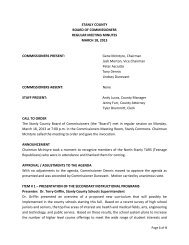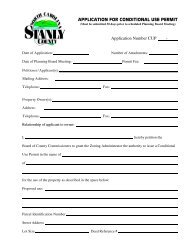Land Use Plan – 2002 - Stanly County, North Carolina
Land Use Plan – 2002 - Stanly County, North Carolina
Land Use Plan – 2002 - Stanly County, North Carolina
You also want an ePaper? Increase the reach of your titles
YUMPU automatically turns print PDFs into web optimized ePapers that Google loves.
STANLY COUNTY<br />
SECTION 6: LAND USE PLAN RECOMMENDATIONS<br />
This section of the report discusses recommendations that address the issues summarized in<br />
Section 5 of this report. Section 6 contains the following information:<br />
Principles to guide long-range land use planning on a countywide basis;<br />
Descriptions of the <strong>Land</strong> <strong>Use</strong> Categories proposed for the <strong>Stanly</strong> <strong>County</strong> <strong>Land</strong> <strong>Use</strong> <strong>Plan</strong>;<br />
and<br />
A summary of growth management and implementation strategies and tools identified to<br />
support the <strong>Land</strong> <strong>Use</strong> <strong>Plan</strong> recommendations.<br />
Section 7 provides an implementation plan to guide the achievement of the plan goals and<br />
recommendations and is included at the end of this report.<br />
Introduction<br />
The <strong>Land</strong> <strong>Use</strong> <strong>Plan</strong> Recommendations are intended to guide the direction and character of longrange<br />
development in <strong>Stanly</strong> <strong>County</strong> over the next 20 years. It is a tool to be used by both public<br />
and private decision-makers that take part in the process of managing growth and development<br />
of <strong>Stanly</strong> <strong>County</strong>. These recommendations take into consideration a wide range of current and<br />
future development patterns. The plan will directly serve as a framework for land use and zoning<br />
decision-making for the study area identified in Figure 1-2 by elected and appointed<br />
commissions and boards as well as county staff. Figure 6-1 illustrates the long-range <strong>Land</strong> <strong>Use</strong><br />
<strong>Plan</strong> Recommendations for <strong>Stanly</strong> <strong>County</strong>.<br />
The <strong>Stanly</strong> <strong>County</strong> <strong>Land</strong> <strong>Use</strong> <strong>Plan</strong> was developed through an evaluation of the existing physical<br />
and socioeconomic environment, current development trends, and public input. The constraints<br />
and opportunities presented earlier in this report have been addressed in the plan<br />
recommendations. The plan attempts to balance the reality between existing conditions and the<br />
possibilities of future development patterns. The <strong>Land</strong> <strong>Use</strong> <strong>Plan</strong> for <strong>Stanly</strong> <strong>County</strong> is illustrated in<br />
Figure 6-1.<br />
Principles of the <strong>County</strong> <strong>Land</strong> <strong>Use</strong> <strong>Plan</strong><br />
The <strong>County</strong> <strong>Land</strong> <strong>Use</strong> <strong>Plan</strong> responds to a series of issues and opportunities that were defined<br />
though both the analysis of existing conditions and the extensive community input that was<br />
completed earlier in the planning process.<br />
Countless residents expressed concern that future development in <strong>Stanly</strong> <strong>County</strong> will continue to<br />
encroach upon open areas and farmland. Many others were fearful of <strong>Stanly</strong> <strong>County</strong> becoming<br />
another Charlotte/Mecklenburg <strong>County</strong> with its accompanying traffic, sprawl, higher housing<br />
costs, and other negative manifestations of urban development.<br />
Although residents generally agreed that it would be impossible and undesirable to stop<br />
development in the county, the question remained: How can new development be managed so<br />
that the unique physical and social qualities that define the rural areas of <strong>Stanly</strong> <strong>County</strong> as well<br />
as the collection of cities and towns could be preserved?<br />
Through a series of nine basic planning principles, the <strong>Land</strong> <strong>Use</strong> <strong>Plan</strong> addresses the proposed<br />
transition from medium to relative dense development patterns in <strong>Stanly</strong> <strong>County</strong>’s eight cities<br />
and other population centers to the rural, farming landscape of much of the rest of the county.<br />
<strong>Land</strong> <strong>Use</strong> <strong>Plan</strong> 6-1 6/02






